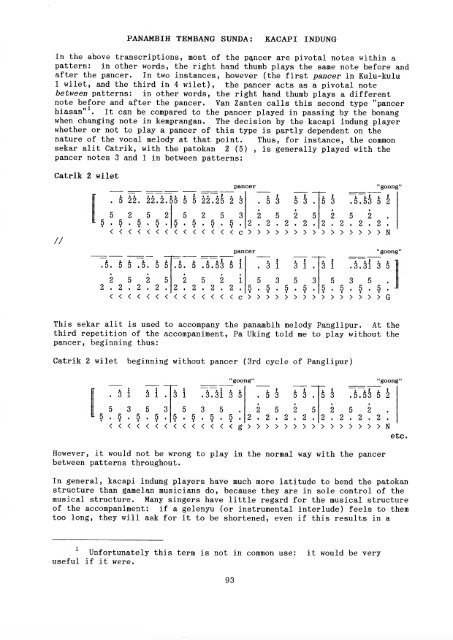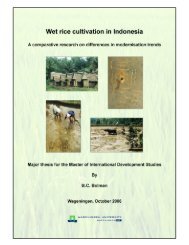Guide to Sundanese Music - Free EBooks Library
Guide to Sundanese Music - Free EBooks Library
Guide to Sundanese Music - Free EBooks Library
You also want an ePaper? Increase the reach of your titles
YUMPU automatically turns print PDFs into web optimized ePapers that Google loves.
PANAMBIH TEMBANG SUNDA: KACAPI INDUNG<br />
In the above transcriptions, most of the p^ncer are pivotal notes within a<br />
pattern: in other words, the right hand thumb plays the same note before and<br />
after the pancer. In two instances, however (the first pancer in Kulu-kulu<br />
1 wilet, and the third in 4 wilet), the pancer acts as a pivotal note<br />
between patterns: in other words, the right hand thumb plays a different<br />
note before and after the pancer. Van Zanten calls this second type "pancer<br />
hiasan" . It can be compared <strong>to</strong> the pancer played in passing by the bonang<br />
when changing note in kemprangan. The decision by the kacapi indung player<br />
whether or not <strong>to</strong> play a pancer of this type is partly dependent on the<br />
nature of the vocal melody at that point. Thus, for instance, the common<br />
sekar alit Catrik, with the pa<strong>to</strong>kan 2 (5) , is generally played with the<br />
pancer notes 3 and 1 in between patterns:<br />
Catrik 2 wilet<br />
//<br />
. 5 22. 22.2,55 5 5 22.^5 2 3<br />
pancer "goong"<br />
.53 53.<br />
. { . . > . i<br />
5 3 .5.53 5 2<br />
2 5 2.<br />
5 2 5 2 5 2 5 3 2 5 2 5<br />
5.5.5.5. 5.5.5.5.<br />
>N<br />
.S. § 5 .§. § 5<br />
.5. 5 .L^h t 1<br />
pancer<br />
H si.<br />
"goong"<br />
§ i .S.M 3 t<br />
5 3 5.<br />
2 5 2 5 2 5 2 1 5 3 5 3<br />
5.5.5.5.<br />
>G<br />
This sekar alit is used <strong>to</strong> accompany the panambih melody Panglipur. At the<br />
third repetition of the accompaniment, Pa Uking <strong>to</strong>ld me <strong>to</strong> play without the<br />
pancer, beginning thus:<br />
Catrik 2 wilet beginning without pancer (3rd cycle of Panglipur)<br />
. 5 i H<br />
.<br />
5 i .§.§i S S<br />
5 3 5.<br />
"goong" "goong"<br />
. !<br />
5 3 h 3 .<br />
5 h .Lhh 5 k<br />
2 5 2.<br />
5 3 5 3<br />
2 5 2 5<br />
0*0*DaO« 0.0.0.0.<br />
>N<br />
However, it would not be wrong <strong>to</strong> play in the normal way with the pancer<br />
between patterns throughout.<br />
In general, kacapi indung players have much more latitude <strong>to</strong> bend the pa<strong>to</strong>kan<br />
structure than gamelan musicians do, because they are in sole control of the<br />
musical structure. Many singers have little regard for the musical structure<br />
of the accompaniment: if a gelenyu (or instrumental interlude) feels <strong>to</strong> them<br />
<strong>to</strong>o long, they will ask for it <strong>to</strong> be shortened, even if this results in a<br />
Unfortunately this term is not in common use:<br />
useful if it were.<br />
93<br />
it would be very<br />
etc.








